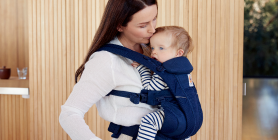- Home
- Blog
November 02, 2012
When I found out I was pregnant I was fairly certain that my plans on ever having a natural birth were out the door but nothing prepared me for the roller coaster ride my son birth turned out to be. I was born with a uterus what was split in two that required reconstructive surgery and even after the surgery I was told I would probably never have children because my FSH levels were too high. Six months after my surgery I was PREGNANT!!! I could not believe it. I was automatically considered high risk and I was fairly disappointed that I wouldn't be able to have a natural birth, and that I wouldn't get to feel labour. To add insult to injury my placenta was covering my cervix. At 20 weeks we scheduled a c section for June 20, my due date was June 30th and even the doctors were skeptical I would make it that far so I was put on bed rest. I was jealous of all of my friends having babies and home births but I was happy I was having my little miracle baby so I did what ever it took to keep him
November 01, 2012
My beautiful Marcella was born in the early morning hours on a Spring morning. This is her story.
I awoke Saturday morning at 4am, March 21, 2009 to a trickle of water. My husband, Josh, wanted to call the midwife but I assured him labor had not begun.
We went back to sleep and woke up around 8am and called the midwife. Per her instructions, we headed over to the birth center a couple hours later.
The midwife gave me a strip to check the fluid and it was indeed amniotic fluid. We left to do some walking around and get some lunch since labor had not started yet.
Around 2 pm the midwife recommended we go home and get some rest since I was still not in labor. After a couple stops (one for Red Raspberry leaf tea), we went home and did just that.
Around 7pm, I went and laid down. Contractions had begun. I had remembered from my Bradley Childbirth classes that if the contractions fade out after a bath, it isn't real labor yet. So my mom got the tub ready for me. The water felt wonderful. My mom
October 24, 2012
Throughout my life, there have been moments I've imprinted on my brain and heart forever. During each of those moments, I've closed my eyes tight to take a mental picture. I store those memories in a special place I access when the first colors of fall fill my eyes, during the quiet moments I spend alone, and in the middle of the night when I cuddle my children back to sleep.
It's there that I hold the last hug I shared with my father before he died, the 10 shades of green on the first hill I laid eyes on in Ireland during a trip with my parents, the moment I realized I was in love with Ash, the first time I locked eyes with Noah, and the car ride to the hospital minutes before meeting Maya where all I could think about was how beautiful life is.
Over the weekend, our family took a tour of the White House, and I stood in front of the Oval Office with each of my children. Looking in at the President's desk, I squeezed my eyes extra tight thinking about how much I love Ash, Noah
October 22, 2012
Christy Turlington Burns is a pretty incredible example of just how much one mom can do: International supermodel, check. Designer, check. Mother of two, check. And in 2010, Christy founded the organization Every Mother Counts (EMC), which helps fund programs that allow mothers around the world to get prenatal care and medical support to safely give birth. This month, Every Mother Counts and Ergobaby are launching the Ergobaby Guest Designer Series. A portion of the Series’ proceeds will benefit EMC; Christy is the first guest designer. Here, she shares a little more about motherhood, managing it all, and what makes her so passionate about this project.
The Ergobaby Designer Series will be benefitting the organization you founded, Every Mother Counts. Do you think western women are aware of how dire the statistics are on maternal mortality?
I know that not enough people are aware that hundreds of thousands of women are still dying each year despite the fact that most of these deaths
October 17, 2012
Our Ergobaby customer service team frequently receives questions regarding the body types/sizes that our Carriers fit. Because of the wide range of body types and styles, we are trying to determine what body size ranges fit our various Collections. By answering the questions below, we should be able to gather data that will help us outline the answer and adapt our carriers to fit a wide arrange of body types. Thank you for helping us with the measurement exercise today. Please fill out the form below by Monday November 5, 2012 and you will be entered to win an Ergobaby Carrier of your choice! You will need a tape measure in inches, a helper, your baby and your Ergobaby Carrier to complete the following form:Open to US residents only. All entries must be received by midnight PST 11/5/2012. To be considered for the giveaway, you must fill out the form above with a valid email address. Winner will be selected randomly and notified via email. Winner will have 5
October 11, 2012
While we don't normally post International blogs, we wanted to share this post with you as the photography is stunning and the story is sweet. This family in Australia speaks about their travels and the Ergobaby...we especially love her term "boundless parenting," as that seems to capture what Ergobaby is all about...happy parents with their children, knowing no bounds. Be sure to click through to the full post to see the rest of the lovely photos. From: Documenting Delight, The Freedom of Babywearing//Boundless Parenting "Today though I wanted to talk to you about the freedom of babywearing – boundless parenting as I like to think of it. This was particularly highlighted to me as we traveled in the Philippines earlier this year. As we were trekking down a steep staircase to a secluded waterfall I called out to Errol “We couldn’t have done this without the Ergo” and he almost scoffed as he called back “We couldn’t have done parenting without the Ergo." Of course he was
October 08, 2012
Make It Count
Hundreds of thousands of women die from pregnancy-related complications each year.
90% of these deaths are preventable.
You can help.
Ergobaby and Christy Turlington Burns' Every Mother Counts have joined forces in an exclusive collaboration.
The Guest Designer collaboration between Ergobaby and Every Mother Counts (EMC) is our first initiative that aims to be a multi-year collaboration with various celebrities led by Christy's Turlington Burns’ vision and creative direction to benefit families everywhere around the world. The result is a new selection of premium Ergobaby products, part of Ergobaby's Designer Collection, with a portion of the proceeds to help prevent pregnancy-related complications.
EMC aims to increase education and support for maternal mortality reduction globally and engage new audiences to better understand the challenges and the solutions while encouraging them to take action to improve the lives of girls and women worldwide.
While
October 04, 2012
In honor of the Design Ergobaby's Next Carrier contest, I thought I’d share my current fall fashion inspirations and some tips to purchase the right Ergo Carrier based on both your personal style and your babywearing needs.
This season the fashion runways and stores have seen a change in trends for fall and winter – no more streamlined and minimalist pieces! It’s all about shape, texture, pattern and color. The top trends I’m loving right now are:
Jewel Tones
The colors of teal, emerald, gold, colbalt, purple and burgundy look good on every skin tone and next to every hair color. I can’t wait to purchase a pair of skinny jeans or a pair of ballet flats in one of these beautiful colors.
Leather
I am a huge fan of a good looking faux leather jacket, specically one that is motorcycle inspired or has that worn in feel.
Bold Prints
Najavo, polka dots, stripes, geometric – I love them all! It’s nice to see basic pieces like a long sleeved sweater or a simple blouse with some pattern to them
October 04, 2012
As a part of National Down syndrome Awareness Month, I’ve been thinking about people with Down syndrome, the unique gifts that this Tribe with an extra chromosome brings with them, as well as the marvelous contributions they make to the world. There are so many – both people with Down syndrome and unique contributions being made:
Zhou Zhou, the internationally acclaimed symphony conductor with Down syndrome. Pablo Pineda, the charismatic teaching expert, who graduated from a major Spanish university and is now a movie star. Karen Gaffney with her astounding athleticism. Sujeet Desai, the highly accomplished musician. Michael Johnson and Bernadette Resha, talented artists. Lauren Potter of Glee. Monica and David , young couple in love. The German dancer, Laura Bruckmann, as photographed by Conny Wenk.
These are fabulous stories of select adults with Down syndrome, busy making stunning contributions to the world. Stories that I grasped and clung to after I found via amniocentesis that
September 29, 2012
When I read the first Mamas Who Inspire post by (and about) Rachel Coleman, I was awe-struck at the challenges this mama has risen to meet. Two special needs children, one deaf, one with spina bifida/cerebral palsy. Nobody would blame her if she had given up; instead, she carried herself (and her children, literally!) gracefully above the obstacles!
I had the wonderful opportunity to chat with her about life and motherhood – here’s more about this inspirational mama!
Motherhood is so all-consuming at times, it’s easy to forget the person we were before we had children – what was life like for you before kids?
I was a musician. About halfway through my first year of college I borrowed my sister’s guitar and taught myself to play. In 3-4 months, I wrote 30+ songs. I dropped out of college…with the full support of my family. I gave myself a year and within the year had radio jingles, was on a Disney Made For TV movie, recorded with local bands, and put out my own album.
I got married
























